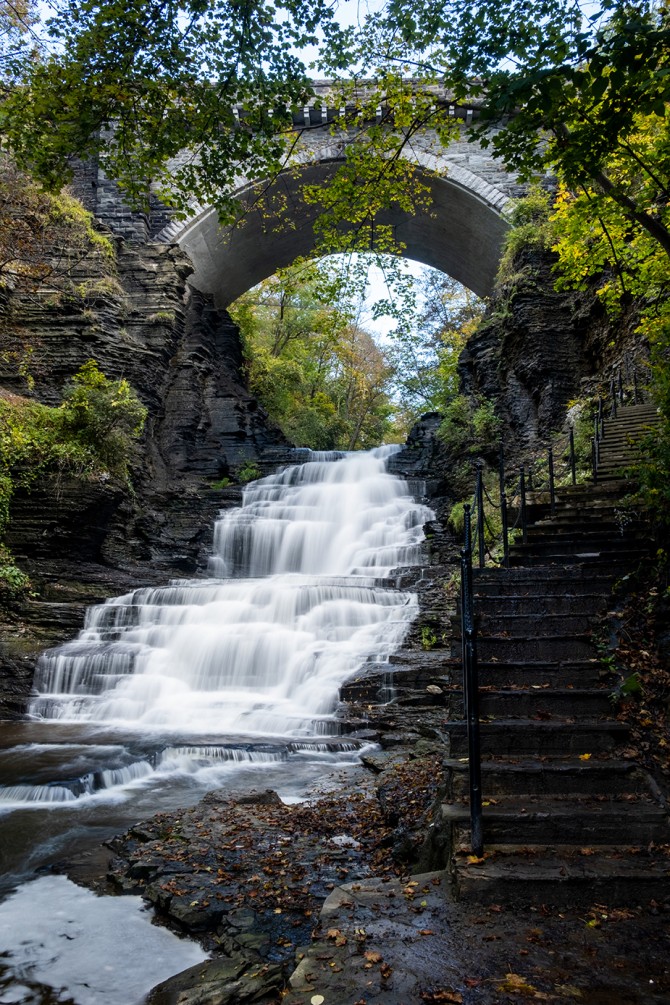The gorges on Cornell’s campus are part of its iconic beauty, and generations of Cornellians have been inspired by hiking through them – but their beauty can belie their potential danger.
“Many students at Cornell grew up in an environment without this fairly unique landscape, and they are not going to know how dangerous it is. It’s not intuitive,” said Todd Bittner, natural areas director for the Cornell Botanic Gardens and chair of the university’s Gorge Safety Committee. “It’s our responsibility to make sure people know how to enjoy the gorges but to stay safe – by staying on the public side of all fences, keeping out of restricted areas, and not swimming anywhere in the gorges.”
Two gorges – Fall Creek and Cascadilla – run through Cornell’s campus, and each has areas where the water has carved deep voids, filled with irregular cavities and debris. As water flows through, it creates unpredictable undertows that have led to fatalities. The steep walls of the gorges and loose stone also pose falling risks; three deaths in the last five years have occurred in and around the city-owned overlook above Ithaca Falls.
To educate visitors about the dangers, the Nathaniel Rand ’12 Memorial Gorge Safety Education Program was founded in 2012 to uphold safety principles and educate the public to prevent future tragedies.
To educate visitors about the dangers, the Nathaniel Rand ’12 Memorial Gorge Safety Education Program – in memory of a student who drowned in a gorge accident in 2011 – was founded in 2012 to uphold safety principles and educate the public to prevent future tragedies. The overall program includes: a comprehensive Gorge Safety website; signage in and around the gorges; a gorge safety video every incoming student is required to watch; a brochure distributed to all first-year students; and orientation hikes for new students. The initiative also includes the Gorge Stewards Program, managed by Cornell Outdoor Education (COE), which employs students and community members to monitor activity in the gorges and educate visitors about safe practices.
This year COE hired seven gorge stewards, six students and one community member, who take four-hour shifts walking through the gorges from May through September.
“We make sure that people aren’t engaging in dangerous behaviors,” said gorge steward Anabella Maria Galang ’23, a biological sciences major in the College of Agriculture and Life Sciences. “We’ve got these massive natural features that are dangerous, but when you see them every day, you may become desensitized. And the water flow can change quickly – from one day to another you could suddenly be working with an entirely different environment. You never know what’s going to happen.”
Since the gorge education program was implemented, the number of violations of gorge regulations has dropped, from more than 8% of all known users in 2013 to less than 0.5% in 2019. However, in 2020, violations jumped to 7.4%, likely due to limited access to public swimming and recreation because of the COVID-19 pandemic. Compliance improved in 2021, but not enough, Bittner said.
“We like to emphasize what you can do instead of swimming in the gorges,” he said. “Go swimming at Taughannock or Treman State Park, where swimming is legal and there are lifeguards. Take a canoeing class with COE. Visit the Botanic Gardens and find 30 miles of hiking trails on- and off-campus. Enjoy the waterfalls from areas that are designated as safe.”
Students and visitors can also explore more than 240 miles of trails in Tompkins County.
Safe off-campus swimming options
Taughannock Falls State Park – life guarded swimming area on the west side Cayuga Lake.
Buttermilk Falls State Park – life guarded swimming in a natural pool at the bottom of Buttermilk Falls.
Robert H. Treman State Park – life guarded swimming in a natural pool at the base of a waterfall.
Myers Park – life guarded swimming on the east side of Cayuga Lake.
Cass Park Pool or Alex Haley Pool – large municipal swimming pools in the city of Ithaca.
The gorge stewards are essential ambassadors of this message in the gorges themselves, Bittner said. They provide directions and information, encourage compliance to gorge safety rules, survey for damage to trails, and track traffic and use, which allows the Gorge Safety Committee to assess the efficacy of its programs.
For Galang, serving as a gorge steward is an opportunity to keep people safe, to interact with a diverse community, to hike and observe the trails over time – and to reflect on the gorges’ power, both physical and metaphorical.
“I’ve always thought the gorges were poetic,” she said. “They come from thousands of years of the water finding these breakages and a path through the rock to form these giant beautiful waterfalls, which makes me think of the academic journey at Cornell, all of us chipping at the unknown and finding our way.”
All the gorge safety program’s components advocate basic safety guidelines: Stay on trails or within designated areas; no bicycles on the trails; no swimming; and stay out of closed trails or other restricted areas marked by fences, gates or railings.
Swimming, in particular, is extremely dangerous and can lead to death, and is strictly prohibited in the gorges at all times. The Gorge Safety site can direct people to information on safe outdoor swimming options off campus. Red emergency locator signs have been installed along the gorge trails to help hikers in distress provide their locations to first responders.





